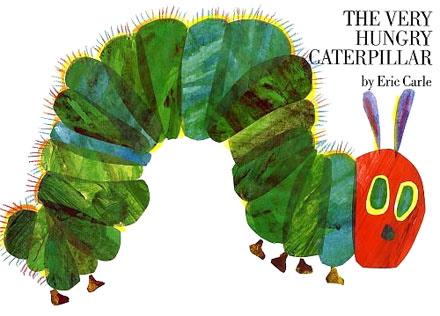The Very Hungry Caterpillar

The Very Hungry Caterpillar by Eric Carle. Photo credit: https://en.wikipedia.org/wiki/The_Very_Hungry_Caterpillar
May 23, 2017
Breaking news! “The last two decades of the 20th century have been hottest in the last 400 years,” (http://www.conserve-energy-future.com). “In the Los Angeles area alone, 10 metric tons of plastic fragments—like grocery bags, straws and soda bottles—are carried into the Pacific Ocean every day” (http://www.ecowatch.com). As scary as it may sound, our habitual actions are gradually showing results on our planet, earth. With this in mind, electric cars, solar panels, reusable coffee cups are new innovations and methods that have been invented over recent generations to reduce harming the environment and the inhabitants of these ecosystems. Of these ideas, a plastic eating caterpillar stands out as one of the craziest, yet coolest contributions in the gradually eco-friendly path. These little critters are actually wax worms who eat a mixture of cereal, grain, bran, honey, and potentially polyethylene plastics. Plastics do not biodegrade, aka decompose, and as a result, when it gets inside other animals’ stomachs they tend to die of undernourishment, suffocation, or lethal poisoning. Due to all these negative impacts, the idea of a plastic eating caterpillar is so beneficial because it will reduce the amount of plastics that are polluting this earth.
Federica Bertocchini, a Spanish scientist from the University of Cantabria, discovered the potential of these caterpillars by taking care of her pet bees. During the short period where she put the wax worms from the honeycomb into a plastic bag, these little critters were able to eat through the plastic and escape. Through this discovery, Bertocchini teamed up with Paolo Bombelli and Christopher Howe to confirm her beliefs that the waxworms were indeed digesting the plastic. Through numerous trials, “they found that each worm created an average of 2.2 holes per hour. Overnight, 100 wax worms degraded 92 milligrams of a plastic shopping bag. At this rate, it would take these same 100 worms nearly a month to completely break down an average, 5.5 gram plastic bag” (http://news.nationalgeographic.com). Although the waxworms were able to digest the plastic, it took 100 worms a month to break it down. Statistically, there would have to be a lot of waxworms to clean up all the plastics in the world.
Fortunately, there are many other organisms such as bacteria and fungi that perform similar actions of digesting plastic. So, the worms themselves might not eat up all the plastic in the world, but they definitely will be a factor of keeping our environment clean. Athena Kieu (10) “thinks that it will definitely help the environment and could potentially save a lot of animals. It’s a great thing!”





































